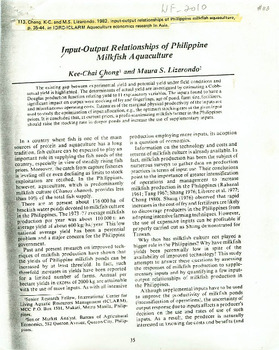Please use this identifier to cite or link to this item:
https://hdl.handle.net/20.500.12348/3612
Input-output relationships of Philippine milkfish aquaculture
| dc.creator | Chong, K.C. | |
| dc.creator | Lizarondo, M.S. | |
| dc.date.accessioned | 2019-06-17T12:56:37Z | |
| dc.date.available | 2019-06-17T12:56:37Z | |
| dc.date.issued | 1982 | |
| dc.identifier | WF_2010.pdf | |
| dc.identifier.citation | p. 35-44. In: IDRC-ICLARM aquaculture economics research in Asia | |
| dc.identifier.uri | https://hdl.handle.net/20.500.12348/3612 | |
| dc.description.abstract | The existing gap between experimental yield and potential yield under field conditions and actual yield is highlighted. The determinants of actual yield are investigated by estimating a Cobb-Douglas production function relating yield to 11 explanatory variables. The inputs found to have a significant impact on output were stocking of fry and finglerlings, age of pond, farm size, fertilizers, and miscellaneous operating costs. Estimates of the marginal physical productivity of the inputs are used to study the optimization of input allocation, e.g. the optimum stocking rate at the given input prices. It is concluded that, at current prices, a profit-maximizing milkfish farmer in the Philippines should raise the stocking rate in deeper ponds and increase the use of supplementary inputs. | |
| dc.format | application/pdf | |
| dc.language | En | |
| dc.publisher | ICLARM | |
| dc.rights | CC BY 4.0 | |
| dc.title | Input-output relationships of Philippine milkfish aquaculture | |
| dc.type | Book Chapter | |
| dcterms.bibliographicCitation | Chong, K.C.; Lizarondo, M.S. (1982). Input-output relationships of Philippine milkfish aquaculture. p. 35-44. In: IDRC-ICLARM aquaculture economics research in Asia | |
| cg.coverage.country | Philippines | |
| cg.identifier.worldfish | 2010 | |
| cg.subject.agrovoc | aquaculture | |
| cg.subject.agrovoc | fry | |
| cg.subject.agrovoc | milkfish | |
| cg.subject.worldfish | stocking | |
| cg.identifier.status | Open access | |
| cg.description.theme | Sustainable aquaculture | |
| worldfish.location.area | Asia |
Files in this item
This item appears in the following Collection(s)
-
Sustainable aquaculture [2735]
